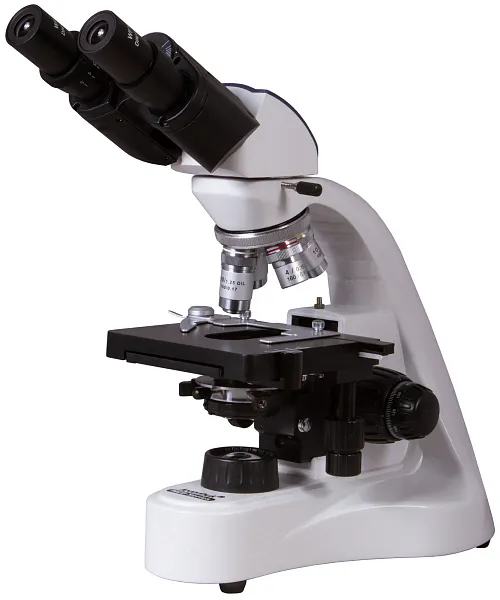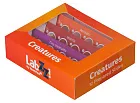Levenhuk MED 10B Binocular Microscope
Magnification: 40–1000x. Binocular head, achromatic objective lenses, and an Abbe condenser with an iris diaphragm, and a filter holder
| Product ID | 73984 |
| Brand | Levenhuk, Inc., USA |
| Warranty | lifetime |
| EAN | 5905555004860 |
| Package size (LxWxH) | 47x38x24 cm |
| Shipping Weight | 5.26 kg |
Levenhuk MED 10B is a laboratory achromatic microscope with a binocular head. It is designed for professional work with microscope slides and can be used for solving various tasks in clinics, scientific centers, research or medical laboratories, educational institutions. The microscope features achromatic optics that allow for conducting observations at up to 1000x magnification. This microscope is suitable for studying bacteria and cellular structures.
A binocular head is located at a convenient 30° angle and provides for comfortable extended observations. It is 360° rotatable.
The eyepieces and objective lenses are made of the optical glass with an anti-fungal coating. The eyepieces provide 10x magnification and a good view that allows for working with extended samples. Achromatic objective lenses are installed in the microscope. Magnification is changed by rotating a revolving nosepiece. A 100x objective lens can be used for observations using oil immersion (a bottle with immersion oil is included in the kit). Objective lenses with high magnification feature spring-loaded frames.
The specimens are placed on a stage with the help of a mechanical scale. The stage is moveable along two axes; fine and coarse sharpness adjustments are available. The light is located under a stage and consists of a bright 5W LED. Between the light and the sample, there is an Abbe condenser with an iris diaphragm and filter holder.
The light is powered by an AC power supply. The illumination system also features a brightness adjustment. Levenhuk MED 10B Microscope is suitable for observing bacteria and cellular structure and examining microscope slides in a laboratory.
Features:
- Laboratory microscope with 40–1000x magnification
- 360° rotatable binocular head, inclined at 30°
- Achromatic optics with an anti-fungal coating
- Lower 5W LED light with brightness adjustment
- Powered by an AC power supply
The kit includes:
- Microscope base with a stand
- 360° rotatable binocular head
- Achromatic objective lenses: 4х, 10х, 40xs, 100хs (oil) with an anti-fungal coating
- Wide-field eyepieces: WF10x/18mm with an anti-fungal coating (2 pcs)
- Abbe condenser N.A. 1.25 with an iris diaphragm and filter holder
- Filters: blue, green, yellow
- Bottle of immersion oil
- Fuse (2 pcs)
- Power cord for microscope
- Dust cover
- User manual and lifetime warranty
Caution:
Please refer to the specifications table for the correct mains voltage and never attempt to plug a 110V device into 220V outlet and vice versa without using a converter. Remember that mains voltage in the U.S. and Canada is 110V and 220–240V in most European countries.
Some things you can see under a microscope:





Levenhuk MED 10B Binocular Microscope is also compatible with other Levenhuk digital cameras (additional cameras are purchased separately). Levenhuk cameras are installed in the eyepiece tube instead of an eyepiece. This microscope is also compatible with any other digital microscope cameras.
| Product ID | 73984 |
| Brand | Levenhuk, Inc., USA |
| Warranty | lifetime |
| EAN | 5905555004860 |
| Package size (LxWxH) | 47x38x24 cm |
| Shipping Weight | 5.26 kg |
| Type | biological, light/optical |
| Microscope head type | binocular |
| Optics material | optical glass with anti-fungal coating |
| Head | 360 ° rotatable |
| Head inclination angle | 30 ° |
| Magnification, x | 40 — 1000 |
| Eyepiece tube diameter, mm | 23.2 |
| Eyepieces | WF10x/18mm (2 pcs.) |
| Objectives | achromatic: 4x, 10x, 40xs, 100xs (oil immersion) |
| Revolving nosepiece | for 4 objectives |
| Interpupillary distance, mm | 48 — 75 |
| Stage, mm | 125х130 |
| Stage moving range, mm | 70/50 (movement in horizontal (X and Y) directions) |
| Coarse focusing travel, mm | 21 |
| Stage features | mechanical double-layer |
| Eyepiece diopter adjustment, diopters | ±5 |
| Condenser | Abbe N.A. 1.25 with an iris diaphragm and filter holder |
| Diaphragm | iris |
| Focus | coaxial, coarse (30mm) and fine (0.002mm) |
| Body | metal |
| Illumination | LED |
| Brightness adjustment | ✓ |
| Power supply | 100–240V |
| Light source type | 5W |
| Light filters | blue, green, yellow |
| User level | beginners, experienced users |
| Assembly and installation difficulty level | easy |
| Application | laboratory/medical |
| Illumination location | lower |
| Research method | bright field |
| Pouch/case/bag in set | dust cover |
We have gathered answers to the most frequently asked questions to help you sort things out
Find out why studying eyes under a microscope is entertaining; how insects’ and arachnids’ eyes differ and what the best way is to observe such an interesting specimen
Read this review to learn how to observe human hair, what different hair looks like under a microscope and what magnification is required for observations
Learn what a numerical aperture is and how to choose a suitable objective lens for your microscope here
Learn what a spider looks like under microscope, when the best time is to take photos of it, how to study it properly at magnification and more interesting facts about observing insects and arachnids
This review for beginner explorers of the micro world introduces you to the optical, illuminating and mechanical parts of a microscope and their functions
Short article about Paramecium caudatum - a microorganism that is interesting to observe through any microscope






















